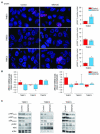PI3K inhibition impairs BRCA1/2 expression and sensitizes BRCA-proficient triple-negative breast cancer to PARP inhibition
- PMID: 22915752
- PMCID: PMC5125254
- DOI: 10.1158/2159-8290.CD-11-0348
PI3K inhibition impairs BRCA1/2 expression and sensitizes BRCA-proficient triple-negative breast cancer to PARP inhibition
Abstract
PARP inhibitors are active in tumors with defects in DNA homologous recombination (HR) due to BRCA1/2 mutations. The phosphoinositide 3-kinase (PI3K) signaling pathway preserves HR steady state. We hypothesized that in BRCA-proficient triple-negative breast cancer (TNBC), PI3K inhibition would result in HR impairment and subsequent sensitization to PARP inhibitors. We show in TNBC cells that PI3K inhibition leads to DNA damage, downregulation of BRCA1/2, gain in poly-ADP-ribosylation, and subsequent sensitization to PARP inhibition. In TNBC patient-derived primary tumor xenografts, dual PI3K and PARP inhibition with BKM120 and olaparib reduced the growth of tumors displaying BRCA1/2 downregulation following PI3K inhibition. PI3K-mediated BRCA downregulation was accompanied by extracellular signal-regulated kinase (ERK) phosphorylation. Overexpression of an active form of MEK1 resulted in ERK activation and downregulation of BRCA1, whereas the MEK inhibitor AZD6244 increased BRCA1/2 expression and reversed the effects of MEK1. We subsequently identified that the ETS1 transcription factor was involved in the ERK-dependent BRCA1/2 downregulation and that knockdown of ETS1 led to increased BRCA1/2 expression, limiting the sensitivity to combined BKM120 and olaparib in 3-dimensional culture.
Significance: Treatment options are limited for patients with TNBCs. PARP inhibitors have clinical activity restricted to a small subgroup of patients with BRCA mutations. Here, we show that PI3K blockade results in HR impairment and sensitization to PARP inhibition in TNBCs without BRCA mutations, providing a rationale to combine PI3K and PARP inhibitors in this indication. Our findings could greatly expand the number of patients with breast cancer that would benefit from therapy with PARP inhibitors. On the basis of our findings, a clinical trial with BKM120 and olaparib is being initiated in patients with TNBCs.
©2012 AACR.
Figures






Comment in
-
Therapeutics: PI3K-PARP combination.Nat Rev Cancer. 2012 Oct;12(10):658. doi: 10.1038/nrc3372. Nat Rev Cancer. 2012. PMID: 23001343 No abstract available.
-
The promise of combining inhibition of PI3K and PARP as cancer therapy.Cancer Discov. 2012 Nov;2(11):982-4. doi: 10.1158/2159-8290.CD-12-0433. Cancer Discov. 2012. PMID: 23148373
References
-
- Schneider BP, Winer EP, Foulkes WD, Garber J, Perou CM, Richardson A, et al. Triple-negative breast cancer: risk factors to potential targets. Clin Cancer Res. 2008;14:8010–8. - PubMed
-
- Tutt A, Robson M, Garber JE, Domchek SM, Audeh MW, Weitzel JN, et al. Oral poly(ADP-ribose) polymerase inhibitor olaparib in patients with BRCA1 or BRCA2 mutations and advanced breast cancer: a proof-of-concept trial. Lancet. 2010;376:235–44. - PubMed
-
- Fong PC, Boss DS, Yap TA, Tutt A, Wu P, Mergui-Roelvink M, et al. Inhibition of poly(ADP-ribose) polymerase in tumors from BRCA mutation carriers. N Engl J Med. 2009;361:123–34. - PubMed
-
- Farmer H, McCabe N, Lord CJ, Tutt AN, Johnson DA, Richardson TB, et al. Targeting the DNA repair defect in BRCA mutant cells as a therapeutic strategy. Nature. 2005;434:917–21. - PubMed
-
- Ashworth A. A synthetic lethal therapeutic approach: poly(ADP) ribose polymerase inhibitors for the treatment of cancers deficient in DNA double-strand break repair. J Clin Oncol. 2008;26:3785–90. - PubMed
Publication types
MeSH terms
Substances
Grants and funding
LinkOut - more resources
Full Text Sources
Other Literature Sources
Medical
Miscellaneous

